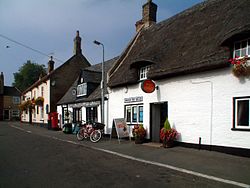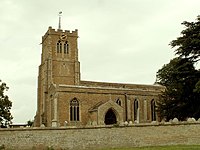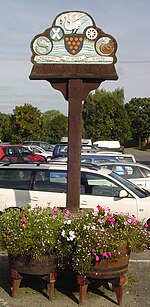Swavesey: Difference between revisions
m Pics etc |
mNo edit summary |
||
| Line 14: | Line 14: | ||
|constituency=South Cambridgeshire | |constituency=South Cambridgeshire | ||
}} | }} | ||
'''Swavesey''' is a village in [[Cambridgeshire]], close by the major A14 route between [[Cambridge]] and [[Huntingdon]], the old Roman ''[[Via Devana]]''. The village stands on the [[ | '''Swavesey''' is a village in [[Cambridgeshire]], close by the major A14 route between [[Cambridge]] and [[Huntingdon]], the old Roman ''[[Via Devana]]''. The village stands on the [[Greenwich Meridian]] and is to be found is 9 miles northwest of [[Cambridge]] and 3 miles south east of [[St Ives, Huntingdonshire]]. | ||
The Cambridgeshire Guided Busway passes through Swavesey, on the line of the old railway, closed in the 1970s. | The Cambridgeshire Guided Busway passes through Swavesey, on the line of the old railway, closed in the 1970s. | ||
Latest revision as of 20:09, 19 May 2014
| Swavesey | |
| Cambridgeshire | |
|---|---|

| |
| Location | |
| Grid reference: | TL364684 |
| Location: | 52°17’51"N, -0°0’0"E |
| Data | |
| Population: | 2,480 (2001) |
| Post town: | Cambridge |
| Postcode: | CB24 |
| Dialling code: | 01954 |
| Local Government | |
| Council: | Cambridge |
| Parliamentary constituency: |
South Cambridgeshire |
Swavesey is a village in Cambridgeshire, close by the major A14 route between Cambridge and Huntingdon, the old Roman Via Devana. The village stands on the Greenwich Meridian and is to be found is 9 miles northwest of Cambridge and 3 miles south east of St Ives, Huntingdonshire.
The Cambridgeshire Guided Busway passes through Swavesey, on the line of the old railway, closed in the 1970s.
Listed as Suauesye in the Domesday Book, the name Swavesey means "Swabian's Island" (Swæfes ieg, or others have suggested Swæf is a personal name, and so "Swæf's island (or landing place)".[1]
History
Swavesey is on a narrow clay ridge rising to 60 feet above sea level at one time surrounded by fenland. The village was of importance during the early Middle Ages as the centre of a large 11th-century estate. A castle was built here in the late 11th or early 12th century, though is believed to have been derelict by 1200.
Swavesey served as a port and subsequent market town and was fortified at the end of the 12th century.[2]
There was already a church in Swavesey at the time of the Norman Conquest, possibly a minster, when Alan, Count of Richmond, granted it to the Abbey of St Sergius and St Bacchus in Angers in Anjou. The Abbey founded an alien priory there by 1086, but the priory was awarded to Alan la Zouche, lord of Swavesey manor, by the start of the 14th century.[2]
Roman pottery has been found in the parish.
Church

The present parish church in Swavesey, dedicated to St Andrew since the 11th century, has a double aisle aspect to its nave. The east window in the Lady Chapel contains a 1967 Tree of Jesse by Francis Skeat.[3] The present building has parts dating from the 11th century, but was substantially improved over the following four centuries.
A Unitarian chapel was built in 1831 on the corner of School Lane and High Street, and the congregation moved to a new Baptist chapel in 1869. The original Unitarian chapel was bought by a group of Methodists and served as their church until it was converted into a bungalow in 1934.[2]
Transport
The railway line from Cambridge to St Ives which passed through Swavesey was opened in 1847 and closed in 1970, but has reopened as the Cambridgeshire Guided Busway.[2]
The parish's north border is formed by the River Great Ouse, formerly an important transport link. The parish's south west border runs along the Via Devana, the old Roman road, that now provides the route of the A14.
Village life

Farming is the main industry in and around Swavesey, although most residents commute to work. A sail-less windmill stands in fields near the village.
There are 3 pubs listed in the village in 1765 and 8 by the early 19th century. By the late 19th century this number had risen to 16, but dropped to 8 by 1912, and only 3 by 1960. Since then the only public house in the village centre has been the White Horse Inn, open since at least 1765, adjacent to the village post office and shop. Notable former pubs include the Rose and Crown on the corner of Boxworth End and Rose and Crown Road which was open by 1765 but closed in the 1880s. The Black Horse on the corner of High Street and Black Horse Lane served from around 1777 until 1910. The Swan (later the Swan with Two Necks) on Station Road was open from around 1777 to 1917. The Blue Bell was active from the late 18th century until around the Second World War. And the George and Dragon also opened in the late 18th century and closed in the first years of the 20th century.
The village's post office opened in the 1850s.[2]
Swavesey Recreation Green off the High Street is a Queen Elizabeth II Field.
The MG Owners' Club has its UK headquarters just outside the village.
Local media
- The Meridian, the village's own community magazine
Outside links
| ("Wikimedia Commons" has material about Swavesey) |
References
- ↑ A. D. Mills (2003). A Dictionary of British Place-Names.
- ↑ 2.0 2.1 2.2 2.3 2.4 A History of the County of Cambridge and the Isle of Ely - Volume 9: Chesterton, Northstowe, and Papworth Hundreds (1989), pages 374–381
- ↑ Low, Malcolm (January 2006). "Swavesey, Cambridgeshire, St. Andrew's Church" (PDF). Tree of Jesse. Malcolm Low TSSF. p. 51. http://homepage.ntlworld.com/m.low1/treeofjesse.pdf. Retrieved 25 December 2010.
